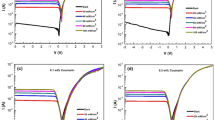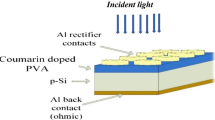Abstract
In this study, Coumarin:TiO2 thin films synthesized by sol-gel method in different coumarin weight ratios were formed by drop casting technique on p-Si. The structural and electrical properties of the synthesized Coumarin:TiO2 thin films were investigated. Nanostructures of synthesized TiO2 were well crystallized at higher Ti concentrations. In addition, photodiode properties of organic-inorganic hybrid Al/p-Si/Coumarin:TiO2/Al samples prepared at varying coumarin concentrations were studied with current-voltage (I-V) characteristics under different illuminations. It was seen that all produced photodiodes had excellent rectifier properties due to the calculated good rectification rates. Also, it was stated that the photocurrents of all produced devices under dark conditions were smaller than those under illumination conditions. Among all the devices fabricated, the highest photosensitivity was observed for photodiode produced with 1% coumarin at under illumination 100 mW/cm2. Electronic parameters such as ideality factor (n) and barrier height (ϕb) were found in ranges 3.1–11.4 and 0.460–0.473 eV, respectively. The temporary photocurrent-time characteristic of the diodes confirmed that the produced devices were light sensitive. Electrical behaviors of the fabricated devices were investigated by means of capacity-voltage (C-V) and conductivity-voltage (G-V) measurements at different frequencies. It was determined that capacity and conductivity decreased and increased, respectively by increasing frequency. This behavior is due to the presence of the interface states of the produced samples. Structural and electrical characterization results showed that all fabricated devices could be operated as optical sensors or photodiodes in optoelectronic fields.
Similar content being viewed by others
References
Forrest SR (2004) The path to ubiquitous and low-cost organic electronic appliances on plastic. Nature 428:911–918. https://doi.org/10.1038/nature02498
Yıldırım M, Kocyigit A (2018) Characterization of Al/in:ZnO/p-Si photodiodes for various in doped level to ZnO interfacial layers. J Alloys Compd. https://doi.org/10.1016/j.jallcom.2018.07.295
Yakuphanoglu F, Farooq WA (2011) Organic-inorganic photosensor controlled by frequency based on nanostructure 1,4-diaminoanthraquinone and p-silicon. Synth Met. https://doi.org/10.1016/j.synthmet.2010.11.045
Yakuphanoglu F, Senkal BF (2009) A hybrid p-Si/poly(1,4-diaminoanthraquinone) photoconductive diode for optical sensor applications. Synth Met 159:311–314. https://doi.org/10.1016/j.synthmet.2008.10.003
Yohannes T, Solomon T, Inganäs O (1996) Polymer-electrolyte-based photoelectrochemical solar energy conversion with poly(3-methylthiophene) photoactive electrode. Synth Met 82:215–220. https://doi.org/10.1016/S0379-6779(96)03792-7
Chirvase D, Chiguvare Z, Knipper M et al (2003) Temperature dependent characteristics of poly(3 hexylthiophene)-fullerene based heterojunction organic solar cells. J Appl Phys 93:3376–3383. https://doi.org/10.1063/1.1545162
Yakuphanoglu F (2012) Semiconducting and quartz microbalance (QCM) humidity sensor properties of TiO 2 by sol gel calcination method. Solid State Sci 14:673–676. https://doi.org/10.1016/j.solidstatesciences.2012.03.016
Yıldırım M (2018) Characterization of the framework of Cu doped TiO2 layers: an insight into optical, electrical and photodiode parameters. J Alloys Compd. https://doi.org/10.1016/j.jallcom.2018.09.276
Hendi AA, Yakuphanoglu F (2016) Graphene doped TiO2/p-silicon heterojunction photodiode. J Alloys Compd 665:418–427. https://doi.org/10.1016/j.jallcom.2016.01.045
Okutan M, Basaran E, Bakan HI, Yakuphanoglu F (2005) AC conductivity and dielectric properties of Co-doped TiO2. Phys B Condens Matter 364:300–305. https://doi.org/10.1016/j.physb.2005.04.027
Wu CG, Tzeng LF, Kuo YT, Shu CH (2002) Enhancement of the photocatalytic activity of TiO2 film via surface modification of the substrate. Appl Catal A Gen 226:199–211. https://doi.org/10.1016/S0926-860X(01)00907-3
Soylu M, Al-Ghamdi AA, Farooq WA, Yakuphanoglu F (2016) Correlations for coumarin additive on the electrical and photocatalytic activity of TiO2modified by thiourea. Microelectron Eng. https://doi.org/10.1016/j.mee.2016.01.026
Fujishima A, Rao TN, Tryk DA (2000) Titanium dioxide photocatalysis. J Photochem Photobiol C: Photochem Rev 1:1–21. https://doi.org/10.1016/S1389-5567(00)00002-2
Bensouici F, Bououdina M, Dakhel AA et al (2017) Optical, structural and photocatalysis properties of Cu-doped TiO2 thin films. Appl Surf Sci 395:110–116. https://doi.org/10.1016/j.apsusc.2016.07.034
Ghasemi S, Rahimnejad S, Setayesh SR et al (2009) Transition metal ions effect on the properties and photocatalytic activity of nanocrystalline TiO2 prepared in an ionic liquid. J Hazard Mater 172:1573–1578. https://doi.org/10.1016/j.jhazmat.2009.08.029
Balakrishnan G, Manavalan S, Babu RV, Song JI (2016) Effect of substrate temperature on microstructure and properties of nanocrystalline titania thin films prepared by pulsed laser deposition. Nanosyst Physics, Chem Math 7:621–623. https://doi.org/10.17586/2220-8054-2016-7-4-621-623
Medina-Valtierra J, Sánchez-Cárdenas M, Frausto-Reyes C, Calixto S (2006) Formation of smooth and rough TiO 2 thin films on fiberglass by sol-gel method. Chem Soc 50:8–13
Yamazoe N, Shimizu Y (1986) Humidity sensors: principles and applications. Sensors Actuators A Phys 10:379–398. https://doi.org/10.1016/0250-6874(86)80055-5
Al-Ghamdi AA, Al-Ghamdi AA, Al-Hartomy OA et al (2013) Novel photoconductive Ag/nanostructure ruthenium oxide/p-type silicon Schottky barrier diode by sol-gel method. J Sol-Gel Sci Technol 67:368–375. https://doi.org/10.1007/s10971-013-3090-x
Al-Ghamdi AA, Nawar AM, El-Tantawy F et al (2015) Design and electrical characterization of Au/Anthracene/p-Si/Al organic/inorganic heterojunction. J Alloys Compd 622:243–249. https://doi.org/10.1016/j.jallcom.2014.10.060
Tataroʇlu A, Tuncer H, Al-Ghamdi AA et al (2015) Graphene-cobalt phthalocyanine based on optoelectronic device for solar panel tracking systems. Synth Met 206:15–23. https://doi.org/10.1016/j.synthmet.2015.04.007
Kim GH, Shao L, Zhang K, Pipe KP (2013) Engineered doping of organic semiconductors for enhanced thermoelectric efficiency. Nat Mater 12:719–723. https://doi.org/10.1038/nmat3635
Lee JH, Leem DS, Kim JJ (2010) Effect of host organic semiconductors on electrical doping. Org Electron physics, Mater Appl 11:486–489. https://doi.org/10.1016/j.orgel.2009.12.002
Kahraman S, Çakmak HM, Çetinkaya S et al (2013) The effects of coumarin additive on the properties of ZnO nanostructures. J Phys Chem Solids. https://doi.org/10.1016/j.jpcs.2012.12.005
Khusayfan NM (2016) Coumarin:GO doped Bi2O3composites/p-type silicon hybrid photodiodes. Synth Met. https://doi.org/10.1016/j.synthmet.2016.11.003
Sahin B, Bayansal F, Yuksel M et al (2014) Effect of coumarin concentration on the physical properties of CdO nanostructures. Ceram Int 40:5237–5243. https://doi.org/10.1016/j.ceramint.2013.10.093
Mekki A, Ocaya RO, Dere A et al (2016) New photodiodes based graphene-organic semiconductor hybrid materials. Synth Met. https://doi.org/10.1016/j.synthmet.2015.12.026
Al-Hartomy OA, Gupta RK, Al-Ghamdi AA, Yakuphanoglu F (2014) High performance organic-on-inorganic hybrid photodiodes based on organic semiconductor-graphene oxide blends. Synth Met. https://doi.org/10.1016/j.synthmet.2014.06.001
Yu T, Zhang P, Zhao Y et al (2009) Synthesis and photoluminescent properties of two novel tripodal compounds containing coumarin moieties. Spectrochim Acta - Part A Mol Biomol Spectrosc 73:168–173. https://doi.org/10.1016/j.saa.2009.02.013
Tombak A, Ocak YS, Asubay S et al (2014) Fabrication and electrical properties of an organic-inorganic device based on Coumarin 30 dye. Mater Sci Semicond Process. https://doi.org/10.1016/j.mssp.2014.03.004
Dere A, Soylu M, Yakuphanoglu F (2019) Solar light sensitive photodiode produced using a coumarin doped bismuth oxide composite. Mater Sci Semicond Process 90:129–142. https://doi.org/10.1016/j.mssp.2018.10.009
Li C, Yan D, Wei M (2015) Layer-by-layer assembly of ordered organic-inorganic luminescent film toward sensoring nitrobenzene compound. Sensors Actuators B Chem 216:198–203. https://doi.org/10.1016/j.snb.2015.03.075
Hsieh TJ, Su CC, Chen CY et al (2005) Using experimental studies and theoretical calculations to analyze the molecular mechanism of coumarin, p-hydroxybenzoic acid, and cinnamic acid. J Mol Struct 741:193–199. https://doi.org/10.1016/j.molstruc.2005.02.009
Razi SS, Srivastava P, Ali R et al (2015) A coumarin-derived useful scaffold exhibiting Cu2+induced fluorescence quenching and fluoride sensing (on-off-on) via copper displacement approach. Sensors Actuators B Chem. https://doi.org/10.1016/j.snb.2014.11.082
Zhou L, Wang W, Xu H et al (2009) Bi2O3 hierarchical nanostructures: controllable synthesis, growth mechanism, and their application in photocatalysis. Chem - A Eur J 15:1776–1782. https://doi.org/10.1002/chem.200801234
Dou L, Yang YM, You J et al (2014) Solution-processed hybrid perovskite photodetectors with high detectivity. Nat Commun 5:1–6. https://doi.org/10.1038/ncomms6404
Chandra W, Ang LK, Pey KL, Ng CM (2007) Two-dimensional analytical Mott-gurney law for a trap-filled solid. Appl Phys Lett 90:48–51. https://doi.org/10.1063/1.2721382
Ding XZ, Liu XH, He YZ (1996) Grain size dependence of anatase-to-rutile structural transformation in gel-derived nanocrystalline titania powders. J Mater Sci Lett 15:1789–1791. https://doi.org/10.1007/BF00275343
Shao X, Nie S, Shao L et al (2017) Synthesis, adsorptive, and Photocatalytic properties of carbon nanotubes/TiO<inf>2</inf>Nanocomposite Photocatalysts. Russ J Phys Chem A 91:2629–2635. https://doi.org/10.1134/S0036024417130271
Mekki A, Dere A, Mensah-Darkwa K et al (2016) Graphene controlled organic photodetectors. Synth Met. https://doi.org/10.1016/j.synthmet.2016.03.015
H K (2008) The investigation of temperature dependence of electrical characteristics of the Al/P-Si Schottky diodes with insulator layer. Firat Univ Inst Sci Technol 65
RHW EHR (1988) Metal-semiconductor contacts, 2. Clarendon, Oxford
Gozeh BA, Karabulut A, Yildiz A, Yakuphanoglu F (2018) Solar light responsive ZnO nanoparticles adjusted using Cd and La Co-dopant photodetector. J Alloys Compd. https://doi.org/10.1016/j.jallcom.2017.10.167
Ameen BAH, Yildiz A, Farooq WA, Yakuphanoglu F (2019) Solar light Photodetectors based on Nanocrystalline zinc oxide cadmium doped/p-Si Heterojunctions. Silicon 11:563–571. https://doi.org/10.1007/s12633-017-9656-4
Kim HB, Lee HS (2014) Effect of Mg addition on the electrical characteristics of solution-processed amorphous Mg-Zn-Sn-O thin film transistors. https://doi.org/10.1016/j.tsf.2013.10.116
Selman AM, Hassan Z (2016) Fabrication and characterization of metal-semiconductor-metal ultraviolet photodetector based on rutile TiO<inf>2</inf> nanorod. Mater Res Bull 73:29–37. https://doi.org/10.1016/j.materresbull.2015.08.013
Brillson LJ, Lu Y (2011) ZnO Schottky barriers and Ohmic contacts. J Appl Phys 109. https://doi.org/10.1063/1.3581173
Selman AM (2016) Studies on the influence of growth time on the rutile TiO2 nanostructures prepared on Si substrates with fabricated high-sensitivity and fast-response p-n Heterojunction photodiode. Am J Nano Res Appl 4:23–32. https://doi.org/10.11648/j.nano.20160403.11
Li J-Y, Chang S-P, Hsu M-H, Chang S-J (2017) Influence of annealing ambience on TiO 2 film ultraviolet Photodetector. ECS J Solid State Sci Technol 6:Q3056–Q3060. https://doi.org/10.1149/2.0121702jss
Liu Z, Li F, Li S et al (2015) Fabrication of UV Photodetector on TiO <inf>2</inf> /diamond film. Sci Rep 5:1–7. https://doi.org/10.1038/srep14420
Balakrishnan G, Bandi VR, Rajeswari SM et al (2013) Effect of oxygen partial pressure on microstructural and optical properties of titanium oxide thin films prepared by pulsed laser deposition. Mater Res Bull 48:1901–1906. https://doi.org/10.1016/j.materresbull.2013.07.009
Ocaya RO, Al-Sehemi AG, Al-Ghamdi A et al (2017) Organic semiconductor photosensors. J Alloys Compd. https://doi.org/10.1016/j.jallcom.2016.12.381
Ocaya RO, Al-Ghamdi A, Mensah-Darkwa K et al (2016) Organic photodetector with coumarin-adjustable photocurrent. Synth Met. https://doi.org/10.1016/j.synthmet.2016.01.002
Liu H, Bala H, Zhang B et al (2018) Thickness-dependent photovoltaic performance of TiO2blocking layer for perovskite solar cells. J Alloys Compd 736:87–92. https://doi.org/10.1016/j.jallcom.2017.11.081
Nemade K, Dudhe P, Tekade P (2018) Enhancement of photovoltaic performance of polyaniline/graphene composite-based dye-sensitized solar cells by adding TiO2 nanoparticles. Solid State Sci 83:99–106. https://doi.org/10.1016/j.solidstatesciences.2018.07.009
Yakuphanoglu F (2016) Transparent metal oxide films based sensors for solar tracking applications. Compos Part B Eng 92:151–159. https://doi.org/10.1016/j.compositesb.2016.02.039
Tataroğlu A, Al-Sehemi AG, Ilhan M et al (2017) Optical, electrical and Photoresponse properties of Si-based diodes with NiO-doped TiO2 film prepared by sol-gel method. Silicon 10(3):913–920. https://doi.org/10.1007/s12633-016-9548-z
Çakar M, Onganer Y, Türüt A (2002) The nonpolymeric organic compound (pyronine-B)/p-type silicon/Sn contact barrier devices. Synth Met 126:213–218. https://doi.org/10.1016/S0379-6779(01)00550-1
Dobročka E, Osvald J (1994) Influence of barrier height distribution on the parameters of Schottky diodes. Appl Phys Lett 65:575–577. https://doi.org/10.1063/1.112300
Nicollian EH, Goetzberger A (1967) The Si-Si0 Interface - electrical properties. BELL Syst Tech J XLVI:1055–1133
Ugur A, Gencer Imer A, Ocak YS (2015) Electrical and photoelectrical characterization of an organic-inorganic heterojunction based on quinoline yellow dye. Mater Sci Semicond Process 39:569–574. https://doi.org/10.1016/j.mssp.2015.05.040
Koç MM, Aslan N, Erkovan M et al (2019) Electrical characterization of solar sensitive zinc oxide doped-amorphous carbon photodiode. Optik (Stuttg). https://doi.org/10.1016/j.ijleo.2018.10.008
Aslan N, Koç MM, Dere A, et al (2018) Ti doped amorphous carbon (Al/Ti-a: C/p-Si/Al) photodiodes for optoelectronic applications. J Mol Struct 813–818
Hill WA, Coleman CC (1980) A single-frequency approximation for interface-state density determination. Solid State Electron 23:987–993. https://doi.org/10.1016/0038-1101(80)90064-7
Acknowledgements
This study was supported financially by the FUBAP unit of Fırat University with the project TEKF. 18.03. We would like to thank you for their support.
Author information
Authors and Affiliations
Corresponding author
Additional information
Publisher’s Note
Springer Nature remains neutral with regard to jurisdictional claims in published maps and institutional affiliations.
Rights and permissions
About this article
Cite this article
Aslan, F., Esen, H. & Yakuphanoglu, F. Al/P-Si/Coumarin:TiO2/Al Organic-Inorganic Hybrid Photodiodes: Investigation of Electrical and Structural Properties. Silicon 12, 2149–2164 (2020). https://doi.org/10.1007/s12633-019-00306-2
Received:
Accepted:
Published:
Issue Date:
DOI: https://doi.org/10.1007/s12633-019-00306-2




